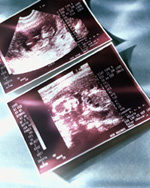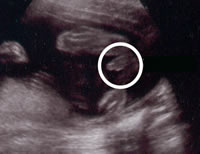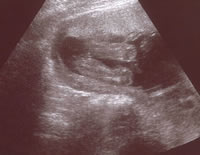Determine Baby’s Sex With Ultrasound
 Ultrasounds are certainly one of the better tests to have during your pregnancy – seeing the baby on the screen really brings home the miracle of a developing and ever growing baby inside your body.
As your pregnancy develops and you start to get curious about your baby, one of the most common questions is “Is it a girl or a boy?” So let’s take a quick look at how you can use the ultrasound to determine the sex of your baby.
Of course if you don’t want to know the sex of your baby, then be sure to let the sonographer know this before he or she begins the procedure.
Ultrasounds are certainly one of the better tests to have during your pregnancy – seeing the baby on the screen really brings home the miracle of a developing and ever growing baby inside your body.
As your pregnancy develops and you start to get curious about your baby, one of the most common questions is “Is it a girl or a boy?” So let’s take a quick look at how you can use the ultrasound to determine the sex of your baby.
Of course if you don’t want to know the sex of your baby, then be sure to let the sonographer know this before he or she begins the procedure.
Using ultrasound to determine if it’s a boy
 In order to determine that your baby is a boy the sonographer will need to be able to determine the shape of a penis and scrotum between your baby’s legs. This is usually possible to determine from around 20 weeks onwards, although it is also possible for some boys to show a little earlier.
It is important that the umbilical cord not be mistaken for a penis. With modern equipment it should be easy for the sonographer to distinguish the penis from the umbilical cord. It is an advantage if the equipment has a color Doppler, as this can be used to identify the umbilical cord. A color doppler is used to show blood flow, and so this would easily distinguish between the cord and a penis.
In order to determine that your baby is a boy the sonographer will need to be able to determine the shape of a penis and scrotum between your baby’s legs. This is usually possible to determine from around 20 weeks onwards, although it is also possible for some boys to show a little earlier.
It is important that the umbilical cord not be mistaken for a penis. With modern equipment it should be easy for the sonographer to distinguish the penis from the umbilical cord. It is an advantage if the equipment has a color Doppler, as this can be used to identify the umbilical cord. A color doppler is used to show blood flow, and so this would easily distinguish between the cord and a penis.
Using ultrasound to determine if it’s a girl
 It is important to understand that just because you can’t see a penis, it doesn’t mean that your baby is female. This is the most common mistake made by inexperienced sonographers.
It is necessary to confirm the presence of labia in order to confirm that your baby is in fact a girl, rather just looking for the lack of a penis. It can sometimes happen that a boy is incorrectly diagnosed if the baby is lying in a position in which the genital area is partly hidden.
It is important to understand that just because you can’t see a penis, it doesn’t mean that your baby is female. This is the most common mistake made by inexperienced sonographers.
It is necessary to confirm the presence of labia in order to confirm that your baby is in fact a girl, rather just looking for the lack of a penis. It can sometimes happen that a boy is incorrectly diagnosed if the baby is lying in a position in which the genital area is partly hidden.
When can’t you determine the sex?
There are circumstances which may make it difficult to determine the sex, and those include: obesity, decreased amniotic fluid, fetal position or fetal activity. Sometimes it is just too difficult to get a clear view of the genital area, and it is then not possible to determine the sex of your baby.Ultrasound To See Baby’s Gender

